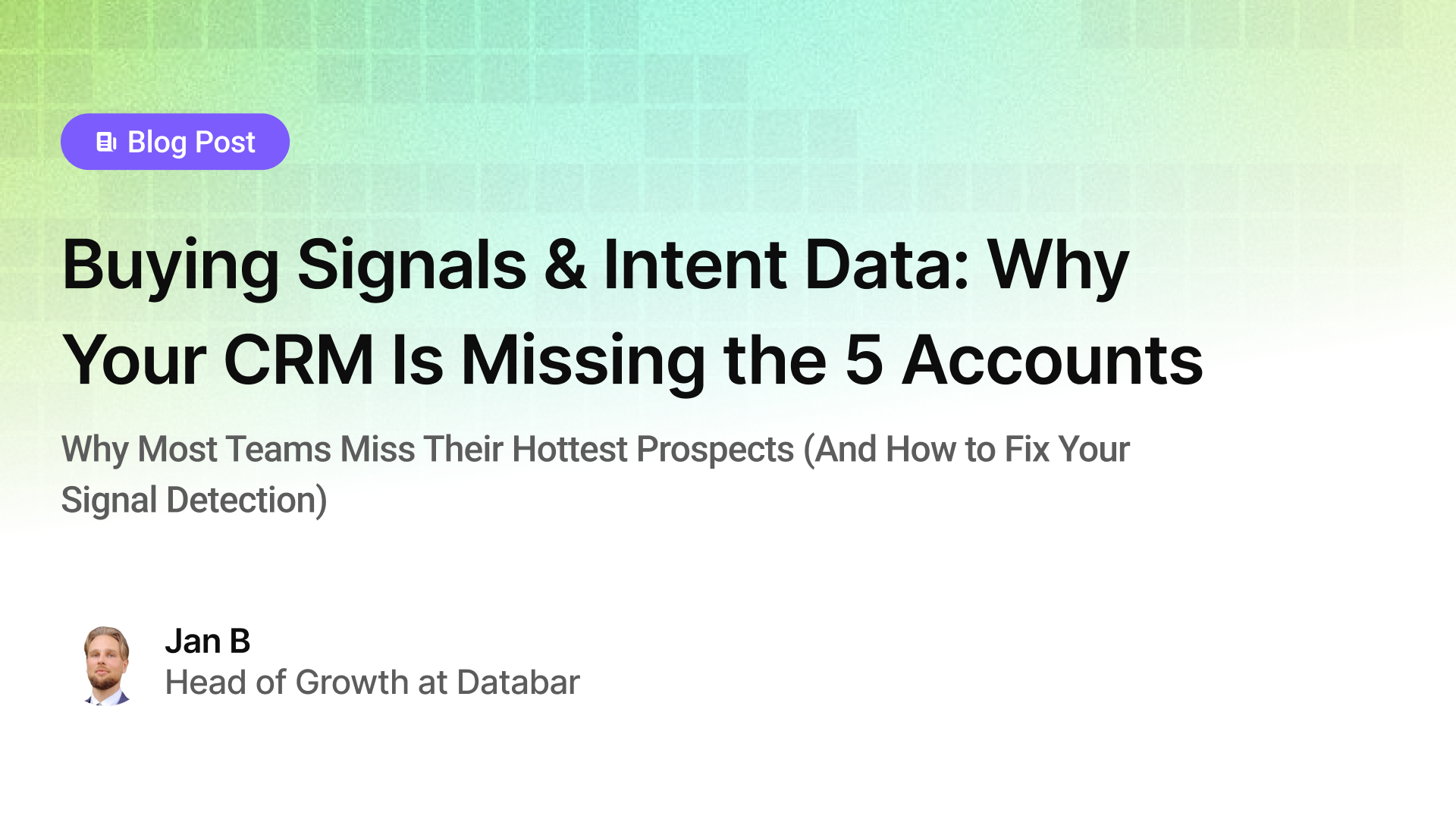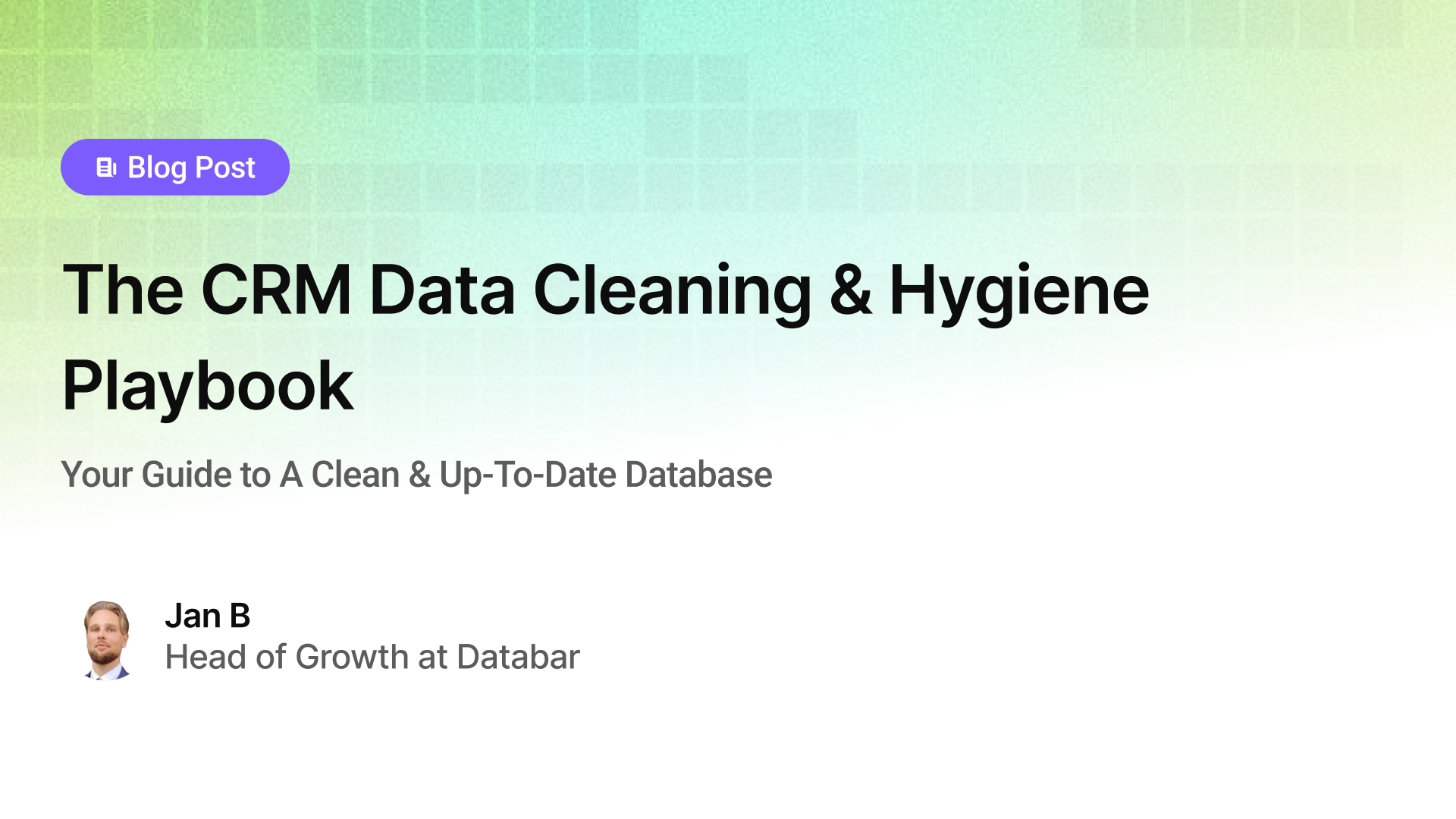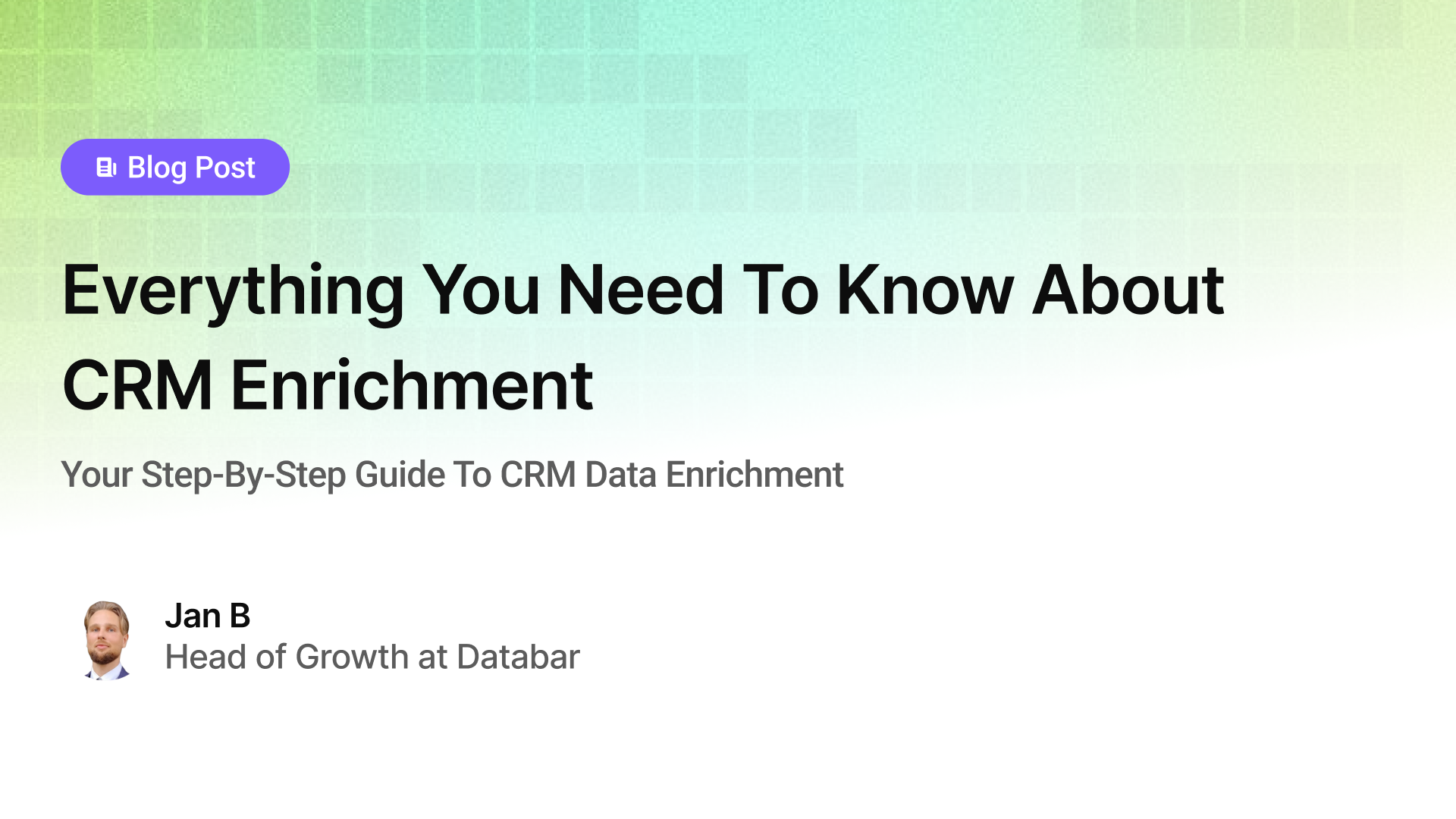First-party, second-party, and third-party data
Understand the differences between internal and external data, as well as how to utilize both as effectively as possible.
Blogby DatabarOctober 18, 2023

Data plays a crucial role in today's business world, particularly in the realm of marketing. However, not all data is created equal. In the world of data analytics, there are several primary types of data: first, second, third, and even zero-party data. Understanding the differences between these types of data and how to effectively use them can significantly impact the success of your marketing efforts. In this blog post, we will delve deeper into the world of data, exploring their definitions, benefits, and best practices for utilizing each type.
What is first-party data?
First-party data is information that companies collect directly from their customers or users. This type of data is incredibly valuable as it is first-hand, reliable, and provides insight into the behavior and preferences of your audience.
Companies can collect first-party data through in several ways, including website analytics, customer surveys, and loyalty programs. For example, Starbucks collects first-party data through its rewards program, allowing the coffee giant to personalize offers and promotions based on individual preferences. Similarly, Amazon uses first-party data to recommend products and services to its customers based on their browsing and purchase history. By collecting and utilizing first-party data, companies can better understand their audience and tailor their marketing efforts to meet their needs and preferences, resulting in more effective campaigns and higher customer satisfaction.
First-party data is generally thought of as the most valuable. As first-party data originates directly from a known source, privacy concerns are also relatively low.
How can first-party data be used in marketing?
There are several ways to utilize first-party data in marketing, including:
Personalize the user experience
With first-party data, companies can tailor their marketing efforts to the specific needs and preferences of their audience. This can include personalized product recommendations, targeted email campaigns, and customized advertising.
Improve ads and retargeting
First-party data can also be used to retarget customers who have already shown an interest in your products or services. For example, if a customer abandons their shopping cart, a company can use first-party data to retarget them with ads or emails reminding them of the items they left behind.
Improve the customer experience
By analyzing first-party data, companies can identify areas where they can improve the customer experience. For example, if customers consistently leave negative feedback about a particular aspect of a product or service, the company can use that information to make necessary changes and improve customer satisfaction.
Measure the success of marketing efforts
First-party data can be used to measure the effectiveness of marketing campaigns. By analyzing data such as click-through rates, conversion rates, and engagement rates, companies can understand which campaigns are resonating with their audience and make data-driven decisions on how to optimize future campaigns.
How Do You Collect First-Party Data?
To collect first-party data, there are various sources that you can use. Enabling a pixel on your website is a great place to start. This tool will receive data about visitors' activity on your site. Another option is to use an integrated audience management platform, such as a data management platform (DMP).
You can also obtain data from other databases, such as customer relationship management (CRM) systems. Customers may provide information when they sign up for your email list or make a purchase on your website. By "onboarding" offline data online, you could match your offline data to online cookies or mobile IDs.
By using an audience management solution, you can gather all the data you get from various sources into one place. Once all the data is in the system, you can manage, analyze, and activate the data for a deeper understanding of your customers.
Besides your website and CRM, other sources include mobile apps, email, SMS, and call centers. Apps obtain meaningful data through user activities such as adding items to your shopping cart. Email and SMS can provide valuable information like open rates, bounce rates, and click rates. Call centers are often a source of information about new account holders and consumer issues, which can help you understand your marketing needs. By using first-party data through beacons, you can understand in-store behaviors and demographics.
What Is Second-Party Data?
If you're looking for additional data to enhance your marketing strategies, second-party data could be a valuable option to explore. It refers to data collected directly from another company's audience.
When it comes to second-party data, you buy it directly from the owner without any intermediaries. However, you need to establish a relationship with the company that has the data you need. Although second-party data comes from a different source, it's similar to first-party data as it originates from a specific audience. It can be obtained from various sources, including website activity, mobile app usage, social media, and customer surveys.
While it's a newer concept compared to first- and third-party data, second-party data can be incredibly useful if you have access to the right data set.
How Can Marketers Use Second-Party Data?
When it comes to obtaining data for your business, second-party data can provide you with valuable insights that you may not be able to get from first-party data alone. One of the benefits of second-party data is that it comes directly from the source, so you can be confident in its quality and accuracy. Unlike aggregated data from multiple sources, second-party data is more precise and targeted to a specific audience.
Another advantage of second-party data is the transparency it offers in the transaction process. Since you're dealing directly with the company that owns the data, you have more control over what you're buying, the terms of sale, and how the information is used.
Cross-Selling
Second-party data can be used to identify customers who may be interested in products or services that are complementary to what you offer. This can help you upsell or cross-sell to customers who are already engaged with your brand.
Audience Expansion
Second-party data can be used to expand your audience by targeting customers who share similar interests or behaviors with the company that owns the data. This can help you reach new customers who may not have been exposed to your brand before.
Predict Behaviors
Second-party data can be used to predict behavior by providing additional insights into the interests, preferences, and behaviors of a specific audience. For example, if you are a marketer for a car company, you may be able to access second-party data from a popular automotive website that has information on the types of cars that their audience is interested in. You could then gain a better understanding of what features and qualities are most important to your target audience.
How Do You Get Second-Party Data?
Second-party data can be a valuable source of customer insights. One way is to establish partnerships with other businesses in your industry that complement your products or services. This can provide opportunities for data sharing and collaboration. Another way is to join data exchange platforms that connect businesses looking to share their data with each other. Additionally, online advertising networks and surveys or focus groups can provide valuable second-party data. When collecting second-party data, it's important to ensure that it is obtained and used in compliance with applicable data privacy laws.
What Is Third-Party Data?
Third-party data is information that you purchase from sources outside your own company. Rather than collecting the data directly from your own audience or customers, it is collected and sold by data aggregators who source it from various websites and platforms. These data aggregators pay publishers and other data owners for their first-party data and then collect it into one large data set to be sold as third-party data. Many companies offer this kind of data, and it is widely available through various channels.
Once the data is aggregated, it is categorized based on factors such as industry, audience behaviors, interests, and demographic characteristics like age and gender. The categories are then segmented further. The buyer can then choose which specific segment they would like to purchase from each individual seller. The name and content of each third-party data segment may differ from provider to provider, so it is important to understand the data's origin before making any purchases to power your campaigns.
Third-party data transactions happen rapidly and programmatically, meaning they take place at scale with minimal manual intervention. The large volume and broad scope of this data can be beneficial, but there are some downsides to consider. For example, you may not know the original source of the data, and it is not exclusive; competitors may have access to the same information.
How Can Marketers Use Third-Party Data?
Third-party data is advantageous due to its volume and reach, allowing you to expand your audience and gain deeper insights into their behaviors and interests. By combining third-party data with first-party data, companies can create a more comprehensive and accurate picture of their target audience.
Enhance First-Party Data
First-party data can be enriched with third-party data to provide additional insights into customers. Third-party data can be used to supplement existing customer profiles with additional demographic, psychographic, or behavioral data that the company may not have collected on its own.
Audience Expansion
Third-party data can be used to expand the reach of your existing audience. By identifying and targeting lookalike audiences, you can reach a larger pool of potential customers who share similar characteristics and behaviors with your existing audience.
Better Targeting
By supplementing first-party data with third-party data, marketers can gain a better understanding of their target audience's interests, behaviors, and preferences. For instance, if a marketer is selling luxury watches, they can use third-party data to identify people who are interested in high-end fashion or luxury goods.
How Do You Get Third-Party Data?
When looking to leverage third-party data, data providers are your go-to source. These providers can be found through various platforms such as DSPs, Audience Management Platforms, and DMPs.
When purchasing third-party data, there are several factors you need to consider - how the provider collects their data, when it was obtained, and the source of the data. You should also be aware of the kind of data that they offer, which can include declared data (user-provided information), inferred data (insights about non-demographic data), and observed data (data gathered from a user's online activity).
There are also different types of audiences that you can consider, such as observed audiences (users who have taken a specific action like purchasing a product or visiting a particular website) and modeled audiences (created by data providers who find users with similar characteristics to observed audiences, which can help to predict future behaviors).
To evaluate the relevance and quality of a data set, you need to have a clear understanding of your objectives and preferences. You should also find out how the provider has organized the data, the price per provider, and the amount of data that you'll receive. Asking the right questions is essential to ensure that you obtain the most helpful data for your campaigns.
What about Zero-Party Data?
Unlike first-party data, which is collected by the company or brand itself, zero-party data comes directly from the user. While first-party data is collected by a company through interactions with their customers, zero-party data is intentionally and voluntarily shared by the customer. This data is explicit and declared, providing more accurate and trustworthy insights into the customer's preferences and intentions.
Zero-party data can be obtained through a variety of sources, including subscriptions, preference centers, quizzes, surveys, pop-up forms, and interactive digital experiences. Usually, users are more willing to exchange this data for an incentive whether it be a prize, token, ir discount.
If you're a marketer looking to obtain zero-party data, it's important to understand the value exchange between you and the user. You must ensure that the user perceives the exchange as being fair and that they feel comfortable sharing their information with you. To make the most of zero-party data, you must also have a clear understanding of how you plan to use it and what kind of value it can bring to your business.
Does First-Party Data Have Higher Privacy Compliance Standards?
When it comes to data privacy, there is no inherent advantage to using first-party data over other types of data. The most important factor in ensuring data privacy is obtaining the consent of the user. This means that users must be informed of what data is being collected and for what purposes, and must have the option to opt-out if they so choose. Consent is the key to ensuring that data collection is done in a privacy-compliant manner.
Combining First, Second, and Third-Party Data
When all three types of data are combined, businesses can develop a more comprehensive understanding of their target audience and their behavior. For example, a business might use first-party data to understand its existing customers, second-party data to learn more about similar customers from a partner company, and third-party data to identify new potential customers who match certain characteristics.
While first-party, second-party, and third-party data can each have their own strengths and weaknesses, using them together can provide a more complete view of a business's target audience and their behavior. By understanding the different types of data and how to use them effectively, businesses can gain a competitive edge and develop more effective marketing strategies.
Learn More About Databar
Databar is a no-code platform that allows users to extract and analyze data from 1000+ APIs. With Databar, users can easily work with different types of data, and enrich their analysis with external data sources. Databar's user-friendly interface and powerful features make it easy for users to gain valuable insights and make data-driven decisions.
One of the key features of Databar is the ability to enrich first party data with data from third-party providers. This means that users can mix their own data, such as data from website analytics or CRM systems, with external data from sources like social media sites, search engines, marketplaces, and other alternative datasets. By enriching their 1st party data with external data, users can gain a more comprehensive view of their business, customers, and competitors.
Related articles

Buying Signals & Intent Data: Why Your CRM Is Missing the 5 Accounts
Why Most Teams Miss Their Hottest Prospects (And How to Fix Your Signal Detection)
by Jan, October 06, 2025

Lead Scoring & Account Segmentation: Why Most CRMs Get This Backward (And How to Fix It)
How to build a system that tells your team who to call, when, and why
by Jan, October 06, 2025

The CRM Data Cleaning & Hygiene Playbook
Your Guide to A Clean & Up-To-Date Database
by Jan, October 04, 2025

Everything You Need To Know About CRM Enrichment
Your Step-By-Step Guide To CRM Data Enrichment
by Jan, October 03, 2025